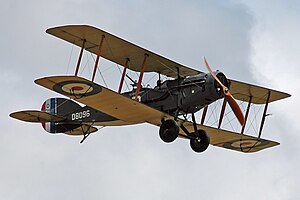Bristol F2b Fighter
| Bristol F.2 Fighter | |
|---|---|
 |
|
| The Shuttleworth Collection's Bristol F.2B Fighter | |
| Role | Biplane fighter aircraft |
| Manufacturer | British and Colonial Aeroplane Company |
| Designer | Frank Barnwell |
| First flight | 9 September 1916 |
| Retired | 1930s |
| Status | 1 |
| Primary users |
Royal Flying Corps Polish Air Force |
| Produced | 1916–1927 (?) |
| Number built | 5,329 |
| Unit cost |
£1,350 (1918)
|
The Bristol F.2 Fighter was a British two-seat biplane fighter and reconnaissance aircraft of the First World War developed by the Bristol Aeroplane Company. It is often simply called the Bristol Fighter or popularly the "Brisfit" or "Biff". Despite being a two-seater, the F.2B proved to be an agile aircraft that was able to hold its own against opposing single-seat fighters. Having overcome a disastrous start to its career, the F.2B's robust design ensured that it remained in military service into the 1930s, and surplus aircraft were popular in civil aviation.
The aircraft's design came about as a result of Frank Barnwell's brief experience as a front-line pilot with the Royal Flying Corps. In March 1916 he started work on aircraft intended, like the R.E.8 and the F.K.8, as possible replacements for the B.E.2c. Barnwell's first proposal used the 120 hp Beardmore engine, and was designated the Type 9 R.2A. This was considered to be underpowered, so a second design, the Type 9A R.2B powered by the 150 hp Hispano Suiza, was proposed.
Neither type was built, as the new 190 hp (142 kW) Rolls-Royce Falcon inline engine became available, and Barnwell designed a new aircraft around it, intended to be a replacement for the F.E.2d and Sopwith 1½ Strutter two-seat fighters. This, the Type 12 F.2A was a two-bay equal-span biplane, closely resembling the R.2A but slightly smaller. Like the previous designs, the fuselage was mounted between the wings, with a gap between the lower longerons and the wing, and the fuselage terminated in a horizontal knife-edge, with a substantial part of the vertical tail surfaces below the fuselage. These features were intended to optimize the field of fire for the observer; the positioning of the fuselage also resulted in the upper wing obscuring less of the pilot's field of view. Work was started on two prototypes in July 1916; on 28 August a contract was awarded for 50 production aircraft, and the first prototype flew on 9 September 1916. The F.2A was armed in what had by then become the standard manner for a British two-seater: one synchronised fixed, forward-firing .303 in (7.7 mm) Vickers machine gun, and one flexible .303 in (7.7 mm) Lewis Gun mounted on a Scarff ring in the observer's rear cockpit.
...
Wikipedia
